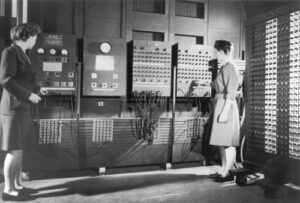RESPONSE: Her Code Got Humans on the Moon—And Invented Software Itself
It is indeed reassuring to read about Hamilton’s journey and her crucial part in a momentous occasion in human history when one considers the strength of perseverance and innovation. It also draws attention to the structural obstacles that women in STEM areas have encountered and still face. This was even highlighted in the article, “It was 1960, not a time when women were encouraged to seek out high-powered technical work.” This article reminded me of the contributions of women to the first computer Electronic Numerical Integrator and Computer, ENIAC.
In the case of the ENIAC, it was programmed by six women: Kay McNulty, Betty Jennings, Betty Snyder, Marlyn Meltzer, Fran Bilas, and Ruth Lichterman. These women were integral to the operation and programming of the ENIAC, performing complex calculations and programming tasks that were critical to the computer’s success. Women’s entry into the industry was perceived as a means of freeing up males for more “skilled” work, as the field was not considered prestigious. Despite their essential roles and substantial technical accomplishments, their contributions were not widely recognized during their lifetimes, and the narrative of computing history often sidelined their efforts.
Question: What mechanisms are present today that either hinder or promote diversity and inclusion in tech and engineering?
RESPONSE: Emotion & Design: Attractive things work better
The theme that I could connect with was “the pleasure of use. As someone deeply invested in the intersection of design and user experience, I’ve always been captivated by products that deliver not just functionality but also the pleasure of use. Take, for example, the tactile feedback of a high-quality mechanical keyboard. Each keystroke produces a satisfying click, transforming the mundane task of typing into an enjoyable experience. It’s not just about the act of typing; it’s about how the device makes me feel while I’m using it.
“true beauty in product design is multi-dimensional, integrating functionality, ease of use, and pleasure”
Question: How can designers balance usability and aesthetics in product design, ensuring that neither aspect is compromised?

